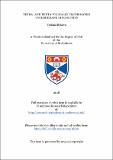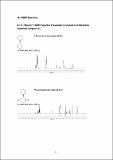Files in this item
Tetra- and penta-vicinally fluorinated cyclohexane ring motifs
Item metadata
| dc.contributor.advisor | O'Hagan, David | |
| dc.contributor.author | Bykova, Tetiana | |
| dc.coverage.spatial | 198 p. | en_US |
| dc.date.accessioned | 2019-10-04T13:39:24Z | |
| dc.date.available | 2019-10-04T13:39:24Z | |
| dc.date.issued | 2019-06-26 | |
| dc.identifier.uri | https://hdl.handle.net/10023/18610 | |
| dc.description.abstract | Organofluorine compounds have had an important influence on the advances in the healthcare and agricultural industries. Selective substitution with fluorine can produce a significant impact on the pharmacokinetic properties of bioactive compounds; generally this is through stereoelectronic effects that the fluorine atom can confer. As such, there is a continuous interest in the development of novel organofluorine compounds and the incorporation of fluorine into bioactive compounds and natural products. The all-cis-1,2,4,5-tetrafluorocyclohexane motifs were the first examples of facially polarised cyclohexane rings which possess a dipolar nature arising from two 1,3-diaxial C-F bonds. The fluorine face, which possesses a negative electrostatic profile, along with the positively polarized methylene hydrogens on the opposite face give a unique facial polarity to this motif. These highly polarized fluorinated ring systems present as novel building blocks for use in drug development and agricultural programs; hence the aim of this study was the development of functionalised derivatives of these all-cis tetrafluoro-cyclohexanes. Transformations of previously reported phenyl all-cis-2, 3, 5, 6-tetrafluoro-cyclohexane were explored in a variety of directions and new pathways towards partially fluorinated cyclohexanes were investigated. The range of all-cis-tetrafluorocyclohexane motifs produced, with functional groups attached directly to the fluorinated cyclohexane ring, varied from methyl substituted all-cis-tetrafluorocyclohexane alcohols, aldehydes, nitriles and amines to all-cis-tetrafluorocyclohexane amino acid, pentafluoro carboxylic acid and alcohol derivatives. These novel derivatives were then used in liquid-phase peptide synthesis, incorporated into peptidomimetic systems through Ugi multi-component reactions and utilised in the formation of bis-systems, in order to demonstrate their reactivity and to gain an insight into their possible intramolecular conformational preferences and supramolecular arrangements. | en_US |
| dc.language.iso | en | en_US |
| dc.publisher | University of St Andrews | |
| dc.subject.lcc | QD412.F1B8 | |
| dc.subject.lcc | QD412.F1B8 | |
| dc.subject.lcsh | Organofluorine compounds | en |
| dc.subject.lcsh | Cyclohexane | en |
| dc.title | Tetra- and penta-vicinally fluorinated cyclohexane ring motifs | en_US |
| dc.type | Thesis | en_US |
| dc.type.qualificationlevel | Doctoral | en_US |
| dc.type.qualificationname | PhD Doctor of Philosophy | en_US |
| dc.publisher.institution | The University of St Andrews | en_US |
This item appears in the following Collection(s)
Items in the St Andrews Research Repository are protected by copyright, with all rights reserved, unless otherwise indicated.


